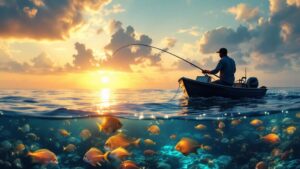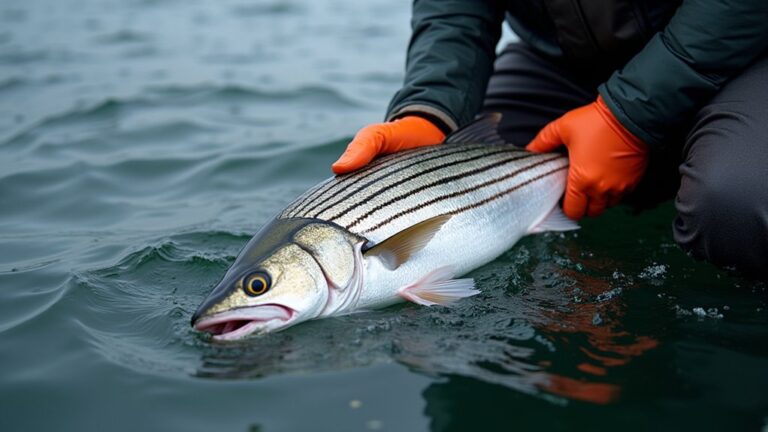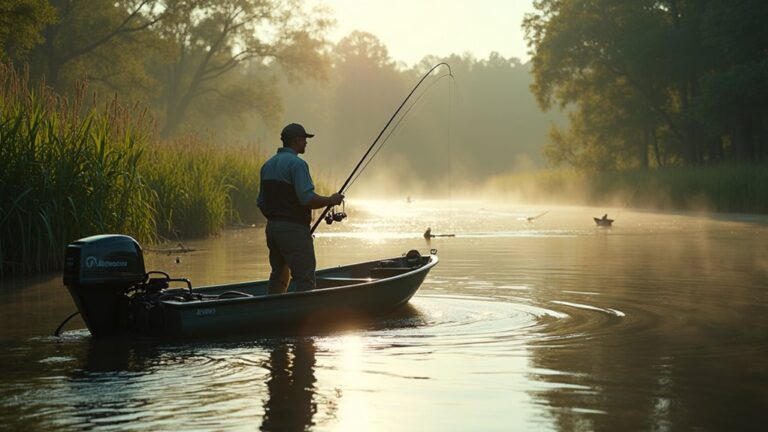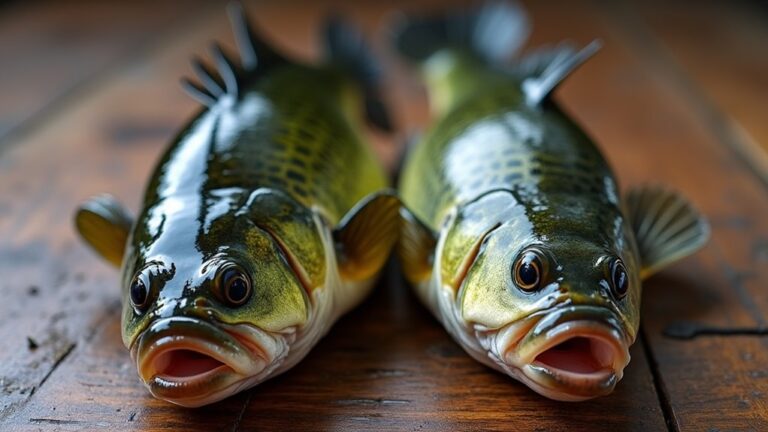To catch saltwater fish effectively, you need to use the right gear and techniques. Start with a sturdy, corrosion-resistant rod and reel combo, and opt for braided line for strength. Experiment with bait like live shrimp or cut mackerel to attract various species. Master casting by maintaining a firm grip and understanding wind direction. Pay attention to tides, as fish are most active during incoming tides. Research the specific species you're targeting, and guarantee you know local regulations. These fundamental techniques can greatly enhance your fishing success, and there's much more to discover about optimizing your saltwater adventures.
Essential Gear for Saltwater Fishing
When it comes to saltwater fishing, having the right gear can make all the difference in your success on the water.
You'll want to start with a sturdy rod and reel combo designed to handle the unique challenges of saltwater environments. Look for a rod with enough backbone to reel in larger fish, and choose a reel that's corrosion-resistant, as saltwater can be harsh on equipment.
Next, consider your line. A braided line is often preferred for saltwater fishing due to its strength and sensitivity. It can handle the abrasion from rocks and reefs while giving you better control over your catch.
Don't forget about terminal tackle; high-quality hooks, swivels, and leaders are vital for preventing break-offs and ensuring a solid hook set.
Lastly, invest in a tackle box to keep everything organized and easily accessible while you're out fishing.
You'll find that having your gear ready to go can save you time and increase your chances of landing that big catch.
With the right gear in hand, you'll be well-prepared to tackle the saltwater challenges ahead and enjoy a successful fishing trip.
Selecting the Right Bait
Choosing the right bait is crucial for attracting the fish you're targeting in saltwater environments. The bait you select can make all the difference between a successful day on the water and coming home empty-handed.
You'll want to evaluate the species you're after, as different fish have varying preferences for bait types.
Here are some popular bait choices that can help you reel in your catch:
- Live bait: Freshly caught shrimp, baitfish, or crabs can entice fish more effectively than artificial options.
- Cut bait: Pieces of fish, such as mackerel or squid, often attract larger species and can create a strong scent trail.
- Artificial lures: Jigs, plugs, and soft plastics allow you to mimic the movement of live prey, making them appealing to predatory fish.
Experimenting with different baits can be exciting and rewarding.
Don't be afraid to adjust your approach based on the conditions you encounter.
Remember, the right bait not only increases your chances of a catch but also enhances your overall fishing experience.
Effective Casting Techniques
Effective casting techniques are essential for maximizing your success in saltwater fishing. To begin, practice your grip on the rod and reel. Use a firm yet relaxed hold, allowing for better control during your cast.
Next, focus on your stance; keep your feet shoulder-width apart for stability. As you prepare to cast, rotate your hips and shoulders back, then smoothly bring the rod forward, releasing your line at the right moment.
When you're casting long distances, try the overhead cast. This technique allows you to send your bait far out into the water. For more accuracy, consider using sidearm casts, which can be helpful when targeting fish near structures like jetties or piers.
Don't forget to pay attention to the wind direction—casting against the wind can lead to tangles and decreased distance. Also, practice your timing; releasing the line too early or too late can throw off your accuracy.
Understanding Tides and Currents
Understanding tides and currents is crucial for successful saltwater fishing. Tides affect the movement of fish, bait, and your ability to cast effectively. By grasping how these natural phenomena work, you can greatly improve your fishing experience and increase your chances of landing that big catch.
Consider these key factors when fishing:
- Timing: Fish are more active during certain tidal phases, like the incoming tide when they feed.
- Location: Current creates structure, drawing fish to areas where they can ambush prey.
- Bait Movement: Understanding how currents affect your bait can help mimic natural movement, making it irresistible to fish.
Pay attention to local tide charts and plan your outings accordingly. By fishing during peak tidal movements, you can take advantage of the increased activity.
Additionally, observe how currents impact your preferred fishing spots. Recognizing these patterns will make you a more effective angler.
Targeting Specific Saltwater Species
Targeting specific saltwater species requires a tailored approach that considers their unique behaviors and habitats. Start by researching the species you're after, whether it's snapper, tarpon, or striped bass. Each has its own feeding patterns and preferences for structure, such as reefs or sandy bottoms.
Next, focus on the right time and location. Many species are more active during dawn and dusk, so plan your trips accordingly. Use local tide charts to find ideal fishing times when fish are likely to be feeding.
Choose the right gear, too. Lighter tackle often works well for smaller species, while heavier setups are necessary for larger game fish. Your bait choice is essential; live bait often outperforms artificial lures, but certain lures can also mimic the natural prey of your target species effectively.
Lastly, pay attention to water temperature and salinity. Different species thrive in varying conditions, so adjust your tactics based on what you observe.
Safety Tips for Anglers
Stay alert while fishing to guarantee a safe and enjoyable experience on the water. Whether you're on a boat or standing on the shore, your safety should always come first. Here are some crucial tips to keep in mind:
- Wear a life jacket: Accidents can happen in an instant. A life jacket can keep you afloat when you need it most.
- Stay hydrated: The sun's heat can dehydrate you quickly. Drinking water regularly helps maintain your energy and focus.
- Check the weather: Sudden storms can turn a fun day into a dangerous situation. Always check the forecast before heading out.
Additionally, make sure you're equipped with a first-aid kit and know basic first-aid procedures.
Familiarize yourself with the local wildlife, as some creatures can be hazardous.
Finally, never fish alone if possible; having a buddy enhances safety and doubles the fun.
By following these safety tips, you'll not only protect yourself but also create unforgettable memories on the water.
Local Regulations and Best Practices
When planning your saltwater fishing trip, knowing the local regulations and best practices can make all the difference. Every state and region has unique rules regarding fishing seasons, size limits, and catch quotas, so it's essential to check these guidelines beforehand. Ignoring them can lead to hefty fines and, more importantly, harm to local fish populations.
Once you're familiar with the regulations, focus on sustainable practices. Always use appropriate tackle and bait to minimize harm to the fish. If you're practicing catch and release, make certain you handle the fish gently, using wet hands to prevent damage to their skin. Consider barbless hooks to make release easier and less harmful.
Additionally, be mindful of your fishing area. Stay clear of breeding grounds and protected habitats to support the ecosystem.
Keep your fishing area clean by disposing of waste properly and respecting wildlife.
Conclusion
Now that you've got the basics of saltwater fishing down, it's time to hit the water and put your skills to the test. You might think it sounds overwhelming, but remember, every expert was once a beginner. Just take it step by step, and you'll soon be reeling in your first catch. Don't let fear hold you back—embrace the adventure and enjoy the thrill of saltwater fishing. You've got this!




